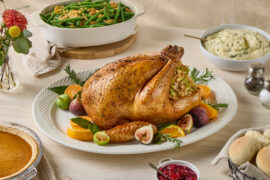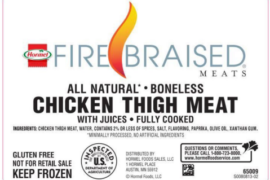The Washington, DC-based National Chicken Council (NCC) projects that American football fans will eat 1.35 billion wings during Super Bowl weekend, an all-time high, as the defending NFL champion New England Patriots battle the Philadelphia Eagles for the Lombardi Trophy on February 4. That figure is up 1.5%, or 20 million wings, from 2017.
“There will be no wing shortage,” said National Chicken Council spokesperson Tom Super. “Whether you’re a fan of the left wing or the right wing, there’s no debate about America’s favorite Super Bowl food – although we do anticipate an uptick in chicken cheese steaks.”
A Wing-Onomics infographic in NCC’s recently released annual Chicken Wing Report graphically illustrates the magnitude of 1.35 billion chicken wings that will be devoured at parties and get-togethers before, during and after the NFL championship game. Needless to say, to satisfy such a voracious appetite, much of the demand is met with frozen, pre-cooked products.
- If laid end to end along Interstate Highway 95, they would stretch from Lincoln Financial Field in Philadelphia, Pennsylvania, to Gillette Stadium in Foxboro, Massachusetts, almost 250 times.
- It’s enough to place 625 wings on every seat in all 32 NFL stadiums.
- 1.35 billion wings in single file would circle Planet Earth three times.
- That equates to 394 million feet of chicken wings – enough that a chicken could cross the road 13 million times.
- Consumers in the United States will eat 20 million more wings this year. If wings were dollars, that would only buy two minutes of television commercial time during the Super Bowl.
Fans Choose Sides
 More than half (59%) of adults in the USA who eat chicken wings say they typically like to consume them with ranch dressing, according to an NCC survey conducted online among 2,086 adults in January 2017 by Harris Poll. The survey asked which dipping sauces or snacks chicken wing eaters typically like to enjoy with their wings. Respondents could choose more than one option.
More than half (59%) of adults in the USA who eat chicken wings say they typically like to consume them with ranch dressing, according to an NCC survey conducted online among 2,086 adults in January 2017 by Harris Poll. The survey asked which dipping sauces or snacks chicken wing eaters typically like to enjoy with their wings. Respondents could choose more than one option.
Ranch is once again the #1 side or sauce typically eaten with wings, and its popularity has been growing steadily – up from 51% in 2014 and 56% in 2015. Only one-third (33%) likes to eat their wings with blue cheese dressing.
The full rankings are: #1 Ranch (59%); #2 (tie) Buffalo/Hot Sauce (48%), #2 (tie) BBQ Sauce (48%); #4 Honey Mustard (35%); #5 Blue Cheese (33%); #6 Teriyaki Sauce (23%); #7 Sriracha (15%) and Nothing/“I eat them naked” (8%).
Bone-in Wings Preference
 According to the survey, 60% of wing eaters prefer traditional, bone-in wings while 40% chose boneless options. In 2015, the spread was 54% vs. 46%, respectively. Boneless wings are not really wings at all, but typically chicken breast meat cut into strips, breaded or floured and tossed with Buffalo sauce.
According to the survey, 60% of wing eaters prefer traditional, bone-in wings while 40% chose boneless options. In 2015, the spread was 54% vs. 46%, respectively. Boneless wings are not really wings at all, but typically chicken breast meat cut into strips, breaded or floured and tossed with Buffalo sauce.
This data parallels with recent research by the NPD Group, which found 64% of chicken wings served in restaurants are bone-in. Servings for the bone-in wings rose by 6% in 2017, while boneless wings declined at a similar rate.
The vast majority of wings, especially those destined for restaurants, are disjointed, with the third joint (the thin part known as the wing tip or flapper) being exported to Asian countries while the meatier first and second joints are sold domestically.
The two segments (or portions) are known as the “drumette” and the “flat,” as opposed to the whole wing. So each chicken produces four wing segments.
Wing-Onomics
 As a chicken only has two wings, supply is limited by the total number of chickens produced. The average price (wholesale, not retail) of whole wings as of January 24, 2018, was $1.56 per pound. That’s down significantly from a peak of $2.13 in September of 2017, according to the Daily Northeast Broiler/Fryer Report by the US Department of Agriculture.
As a chicken only has two wings, supply is limited by the total number of chickens produced. The average price (wholesale, not retail) of whole wings as of January 24, 2018, was $1.56 per pound. That’s down significantly from a peak of $2.13 in September of 2017, according to the Daily Northeast Broiler/Fryer Report by the US Department of Agriculture.
Wing prices traditionally go up in the fourth quarter of the year as restaurants and supermarkets stock up for Super Bowl parties, and prices usually peak in January during the run-up to the big game. Last year, however, saw the opposite trend.
The National Chicken Council estimates that of the wings eaten during Super Bowl weekend, 75% will come from restaurants or foodservice outlets, and 25% from retail grocery stores. According to the NPD Group, the number of restaurants with the word “wings” in their names has grown 18% since 2014.
Although the vast majority of wings eaten during the Super Bowl are purchased from restaurants, bars or wing and pizza joints, wing sales at grocery stores and supermarkets spike dramatically the week of the Super Bowl.
Chicken wings are a strong component of the supermarket fresh chicken category all year, too. At $881 million, they are the third highest grossing cut in the fresh meat chicken category, according to “Nielsen FreshFacts, Total US, 52 weeks ending November 25, 2017.” That’s up 4.6% from a year ago. The two highest grossing cuts are chicken breasts and chicken thighs, respectively.
Although rotisserie chicken rules the roost in the deli prepared chicken category, wings came in a strong third at $590 million, up 5.6% from a year ago, according to the same data. Fried chicken was #2.
Buffalo Wings History
 Deep-fried chicken wings have long been a staple of Southern cooking. But the concept of cooking wings in peppery hot sauce was born in 1964 at the Anchor Bar in Buffalo, New York, when co-owner Teressa Bellissimo prepared leftover wings in hot sauce as a late-night snack for her son and his friends. The guys liked them so much that the Bellissimos put them on the menu the next day. Served with celery slices and bleu cheese sauce, “Buffalo Wings” were an instant hit.
Deep-fried chicken wings have long been a staple of Southern cooking. But the concept of cooking wings in peppery hot sauce was born in 1964 at the Anchor Bar in Buffalo, New York, when co-owner Teressa Bellissimo prepared leftover wings in hot sauce as a late-night snack for her son and his friends. The guys liked them so much that the Bellissimos put them on the menu the next day. Served with celery slices and bleu cheese sauce, “Buffalo Wings” were an instant hit.
Dick Winger, who sold hot sauce to the bar, went on the road with Dominic Bellissimo, the owners’ son, to promote the item and sell hot sauce, and the item gradually caught on with restaurant operators around the country.
The concept hit the big time in 1990, when McDonald’s began selling Mighty Wings at some of its restaurants. KFC rolled out Hot Wings a year later, and Domino’s Pizza introduced its own wings in 1994. They’ve remained hot ever since. McDonald’s was back in the wing business in 2013, and its Mighty Wings were featured nationwide at most restaurants through the first quarter of 2014.
Wings and Football
The rise of the chicken wing and its correlation to American football all had to do with timing.
Cooking whole birds was trendy in the 1960s and 1970s, but in the 1980s, US consumers started preferring boneless-skinless breast meat, and wings became an inexpensive byproduct for chicken producers. Restaurants and bars realized they could charge low prices for the relatively inexpensive protein, and due to the spicy/salty nature of the sauce, they discovered that beer sales would go through the roof when customers ate wings.
At the same time, sports bars with multiple TVs and satellite dishes were becoming more and more common in America thanks to rapidly developing technology – and the most popular sporting event to watch with friends in bars is football. Wings were easily shareable and affordable, a great “group food” to eat with other people, and are the perfect pairing with a pitcher of beer. And so the pigskin-chicken wing bond was born.





